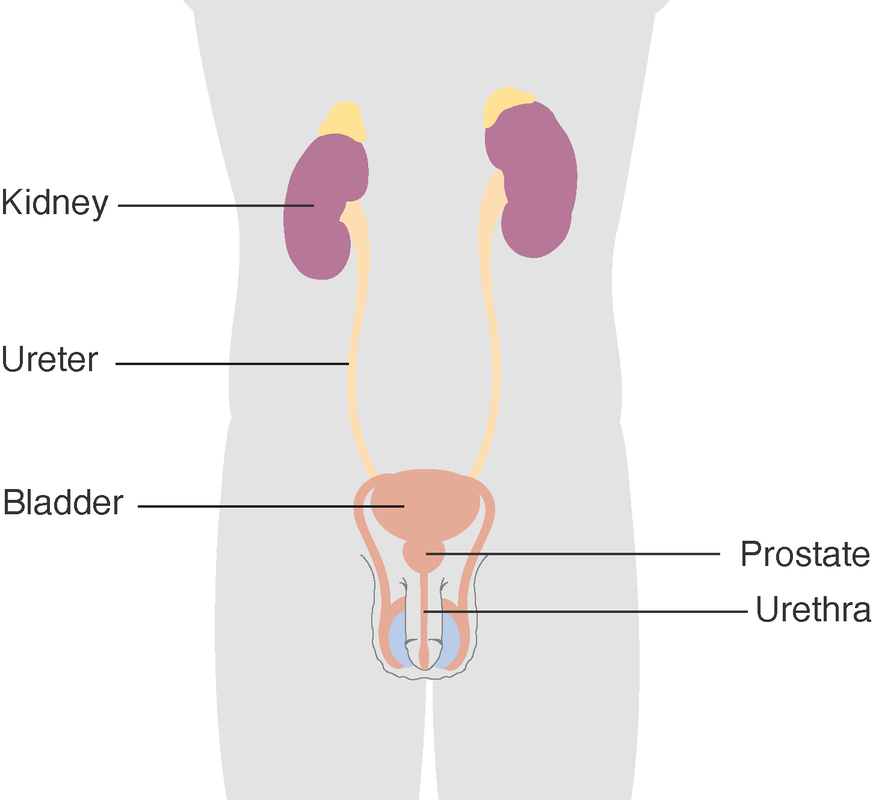|
(Image courtesy of Cancer Research UK) Ureters are a component of the urinary system and are thin tubes of muscle that carry urine from the kidneys to the bladder. In a human adult, the ureters are usually 8–12 in long and very small in diameter (~0.15 in). Though they sound similar, ureters are different from the urethra in that ureters connect the kidneys to the bladder whereas the urethra connects the bladder to the outside body. Sperm is forcefully expelled from the tail of the epididymis into the deferent duct during ejaculation. Sperm then travels through the deferent duct into the pelvic cavity, over the ureter to the prostate behind the bladder. Here, the vas deferens joins with the seminal vesicle to form the ejaculatory duct, which passes through the prostate and empties into the urethra. When ejaculation occurs, muscle movements propel the sperm forward. The ureters have been identified for at least two thousand years, with the word "ureter" stemming from the stem uro- relating to urinating and seen in written records since at least the time of Hippocrates. Nuts & Bolts: Ureters Key terms: Ejaculation - the action of ejecting semen from the body. Epididymis - a highly convoluted duct behind the testis, along which sperm passes to the vas deferens. Seminal vesicle - each of a pair of glands which open into the vas deferens near to its junction with the urethra and secrete many of the components of semen. Sperm - the male reproductive cell or gamete. Ureter - the duct by which urine passes from the kidney to the bladder or cloaca. Urethra - the duct by which urine is conveyed out of the body from the bladder, and which in male vertebrates also conveys semen. Urinary system - also known as the renal system or urinary tract, consists of the kidneys, ureters, bladder, and the urethra. The purpose of the urinary system is to eliminate waste from the body, regulate blood volume and blood pressure, control levels of electrolytes and metabolites, and regulate blood pH. Vas deferens - the duct which conveys sperm from the testicle to the urethra. For additional terminology related to male contraception and the male reproductive system, please visit our glossary: Sources/References: Arthur D. Smith (Editor), Glenn Preminger (Editor), Gopal H. Badlani (Editor), Louis R. Kavoussi (Editor) (2019). "38. Ureteral Anatomy". Smith's textbook of endourology (4th ed.). John Wiley & Sons Ltd. pp. 455–464. ISBN 9781119245193. Standring, Susan, ed. (2016). "Ureter". Gray's anatomy : the anatomical basis of clinical practice (41st ed.). Philadelphia. pp. 1251–1254. ISBN 9780702052309. OCLC 920806541. Kardong, Kenneth (2019). "The urogenital system". Vertebrates : comparative anatomy, function, evolution (8th ed.). New York: McGraw-Hill. pp. 546–552. ISBN 9781260092042. Marx, Franz Josef; Karenberg, Axel (2010). "Uro-words making history: Ureter and urethra". The Prostate. 70 (9): 952–958. doi:10.1002/pros.21129. PMID 20166127. S2CID 32778667. For additional publications related to male contraception and the male reproductive system, please visit our publications page:
Comments are closed.
|
Categories
All
Archives
June 2024
|
|
|
Donate to Male Contraceptive InitiativeYour generous donation makes a difference!
|
© Male Contraceptive Initiative. All rights reserved.


 RSS Feed
RSS Feed
